Digital voice communication in the VHF/UHF bands
Digital voice communication using digital technology in the VHF/UHF band. In the late 20th century, digital technology made great
development, and attempts to use digital voice communication in the world of amateur radio began. The Japan Amateur Radio League (JARL)
and ICOM Co. Ltd. jointly developed the world's first digital mode specialized for amateur radio, D-STAR (Digital Smart Technologies
for Amateur Radio), and a demo machine was released in 2002. In 2004, the world's first digital transceiver ID-1 was released by ICOM,
and repeaters were also installed. In 1998, connection to the public communication network of amateur radio was permitted. This made
it possible to communicate via the Internet using VoIP technology. JARL installed D-STAR server and the network was opened. Reflectors
are installed voluntarily to link worldwide repeaters and individual stations, making it possible to communicate with the whole world
using this mode.
On the other hand, Yaesu Co., Ltd. developed another digital mode called C4FM for amateur radio in the 2000s and released a transceiver
using this mod in 2013. Yaesu had constructed a network on the Internet using analog FM called WIRES-II (Wide-coverage Internet Repeater
Enhancement System), but changed it to digital and deployed a network called
WIRES-X. There are many reflectors called rooms around the
world, and they are also connected to repeaters. In Japan, there are no C4FM repeaters.
In addition to the above two modes, digital mode developed for business use have also been adopted in amateur radio. In particular,
DMR (Digital Mobile Radio), developed by Motorola, has the advantage of being inexpensive because it is used in business, and its use
has rapidly increased. In the early 2000s, Yaesu manufactured and sold radios for business use in partnership with Motorola, but they
are still hardly used in Japanese amateur radio community. P25 (Priject 25) and NXDN (Next Generation Digital Narrowband) are also
beginning to be used, but they are not used in Japan.
D-STAR

![]() In 2014, I moved to Kyoto for five years for my work. I lived at my parents' house in Kyoto, but I couldn't set up an antenna to enjoy
amateur radio, so I decided to try D-STAR for the first time because there was a D-STAR repeater nearby and purchased ICOM's ID-51Plus.
With D-STAR, they say that it is possible to connect to distant repeaters via the Internet. What I expected was that the network would
be globally spread and that my signal could be transmitted from overseas repeaters. However, I found out that JARL's system was not
connected to the reflectors, making it extremely difficult to connect to overseas. I learned from the information in QST, the ARRL's
magazine, that there was a small device called DV-Dongle. I purchased it from the United States immediately. It is a small device
about 8 x 4 cm and 1.5 cm thick. Installing the downloaded driver, I was able to use it immediately.
In 2014, I moved to Kyoto for five years for my work. I lived at my parents' house in Kyoto, but I couldn't set up an antenna to enjoy
amateur radio, so I decided to try D-STAR for the first time because there was a D-STAR repeater nearby and purchased ICOM's ID-51Plus.
With D-STAR, they say that it is possible to connect to distant repeaters via the Internet. What I expected was that the network would
be globally spread and that my signal could be transmitted from overseas repeaters. However, I found out that JARL's system was not
connected to the reflectors, making it extremely difficult to connect to overseas. I learned from the information in QST, the ARRL's
magazine, that there was a small device called DV-Dongle. I purchased it from the United States immediately. It is a small device
about 8 x 4 cm and 1.5 cm thick. Installing the downloaded driver, I was able to use it immediately.
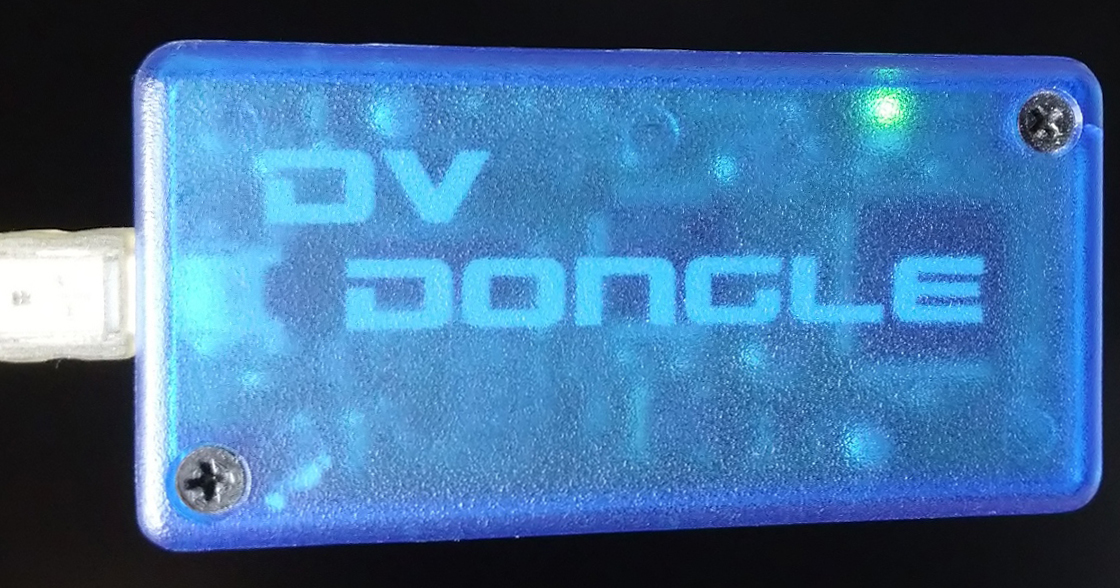
 Reflectors are mainly installed by country, language, and group, and are saved as a list in the software that controls the DV-Dongle.
Selecting and connecting the reflector that I want to use, my voice from my PC reaches the repeaters and personal stations connected to
that reflector. All conversations on the reflector can be heard by everybody who connects, so round QSOs and roll calls are also possible.
Of course, it is easy to communicate with foreign stations, and I enjoyed it very much. However, I didn't use the radio at all, so my ID-51
transceiver was forgotten.
Reflectors are mainly installed by country, language, and group, and are saved as a list in the software that controls the DV-Dongle.
Selecting and connecting the reflector that I want to use, my voice from my PC reaches the repeaters and personal stations connected to
that reflector. All conversations on the reflector can be heard by everybody who connects, so round QSOs and roll calls are also possible.
Of course, it is easy to communicate with foreign stations, and I enjoyed it very much. However, I didn't use the radio at all, so my ID-51
transceiver was forgotten.
So I decided to install a hotspot that could be function as a personal simplex repeater. I purchased NoraGateway, which is distributed by
the XRF Reflector Association in Japan.
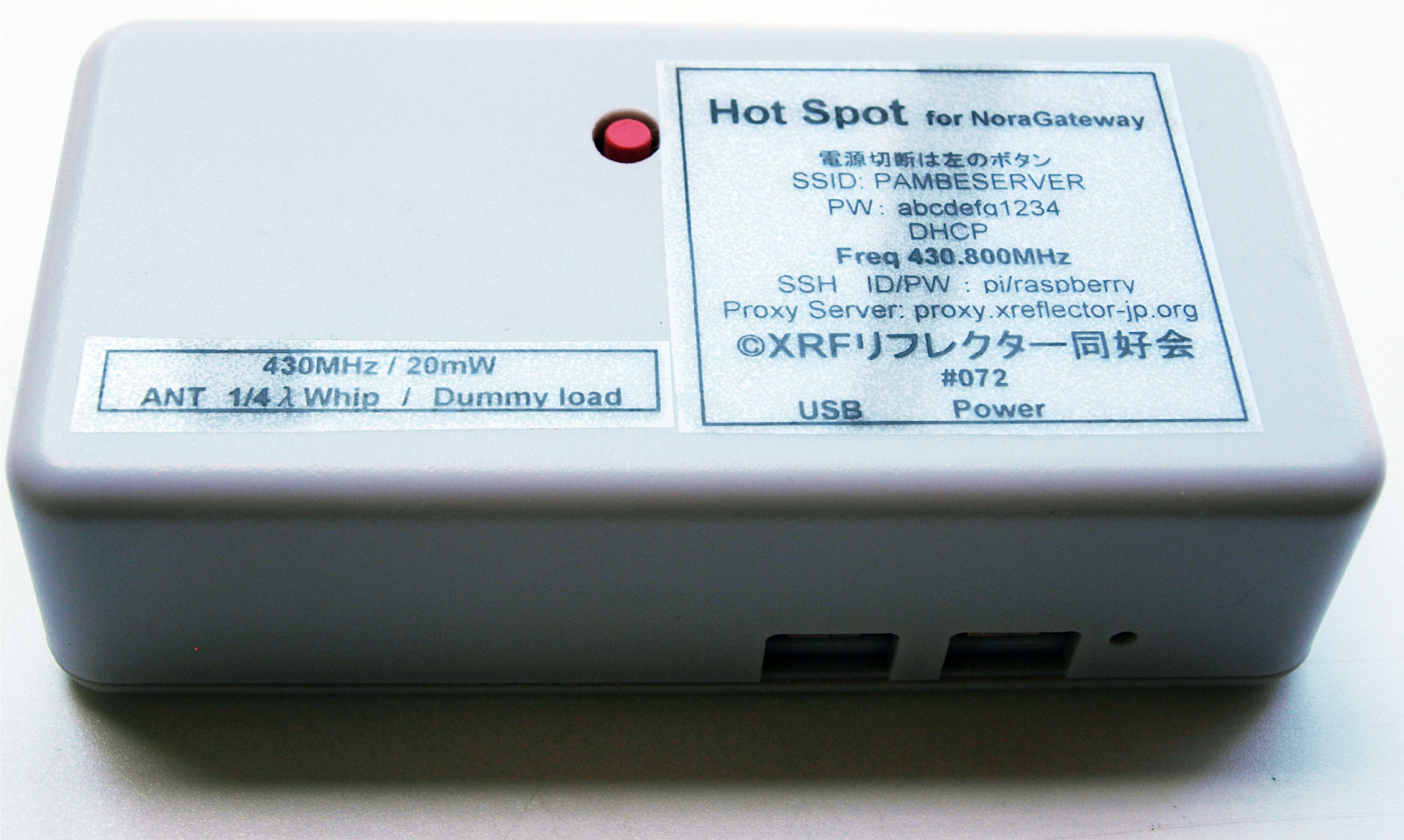 It consists of a 430 MHz band transceiver and a Linux PC called Raspberry Pi that controls it. The size is about 9 cm x 4.5 cm x 2.5 cm,
and the antenna is built-in. Although the output is only 20 mW, a radio station license is required under the Japanese Radio Law, and the
same call sign is prohibited from communicating with each other, so a different call sign is required for my ID-51 and hotspot. I applied
to the Ministry of Internal Affairs and Communications and obtained a new call sign, JF9RGC, as a fixed station.
It consists of a 430 MHz band transceiver and a Linux PC called Raspberry Pi that controls it. The size is about 9 cm x 4.5 cm x 2.5 cm,
and the antenna is built-in. Although the output is only 20 mW, a radio station license is required under the Japanese Radio Law, and the
same call sign is prohibited from communicating with each other, so a different call sign is required for my ID-51 and hotspot. I applied
to the Ministry of Internal Affairs and Communications and obtained a new call sign, JF9RGC, as a fixed station.
The small PC of this device is connected to the Internet via LAN or WiFi. It constitutes the gateway for the signals received by the
transceiver and the signals flowing from the Internet. Signals from the net are transmitted from the transceiver. The output of this transceiver
is very low, so it cannot be accessed from a distance from the hotspot, but I can enjoy chatting with overseas stations with a handy tranceiver
while working at home or in the garden. If the reflector to be connected is written to the transceiver's memory in advance, the connection can
be changed remotely.
C4FM and WIRES-X
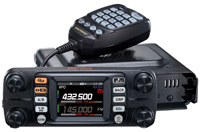 I also wanted to QRV with C4FM, so I bought the FTM-300D of Yaesu. As mentioned above, there is no C4FM repeater in Japan. Instead,
it is possible to set up a node as a private repeater connected to Internet. However, in order to do so, it is necessary to purchase
an interface called HRI-200 to connect FTM-300D to a PC. Fortunately, this FTM-300D has a system called portable HRI mode that allows
to connect to PC only using USB interface. With the WIRES-X software running on the windows PC, I can access the
WIRES-X network and
connect to different rooms.
I also wanted to QRV with C4FM, so I bought the FTM-300D of Yaesu. As mentioned above, there is no C4FM repeater in Japan. Instead,
it is possible to set up a node as a private repeater connected to Internet. However, in order to do so, it is necessary to purchase
an interface called HRI-200 to connect FTM-300D to a PC. Fortunately, this FTM-300D has a system called portable HRI mode that allows
to connect to PC only using USB interface. With the WIRES-X software running on the windows PC, I can access the
WIRES-X network and
connect to different rooms.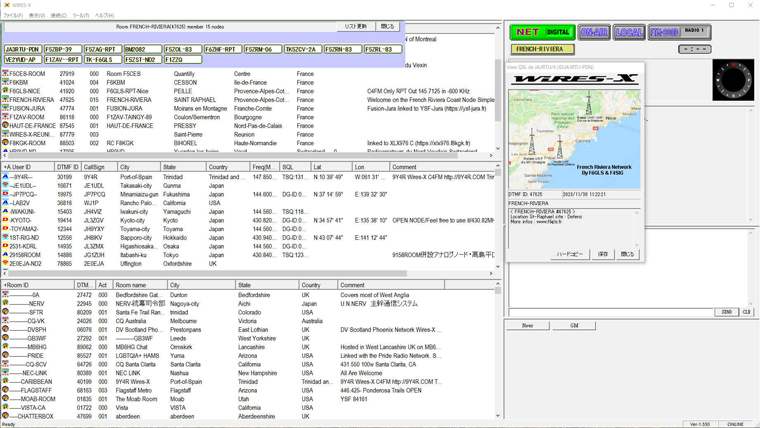
Setting up Multi-mode Hotspot and Pi-Star
Since around 2018, I have been hearing more and more about multi-mode hotspots from overseas stations. It uses a multi-mode modem (Multi Mode
Digital Voice Modem: MMDVM) to support all the digital modes currently used in amateur radio, i.e. D-STAR, C4FM, DMR, P25 and NXDN. I noticed
that the board in the NoraGateway I use was MMDVM, so I decided to use it. In the NoraGateway, the antenna was a built-in dummy load and a short
wire, but I added an SMB connector to restore it to its original one. I also added a 0.93-inch OLED display. This MMDVM board was combined with
a Raspberry Pi 3 A+ and assembled in an acrylic case purchased from the USA.
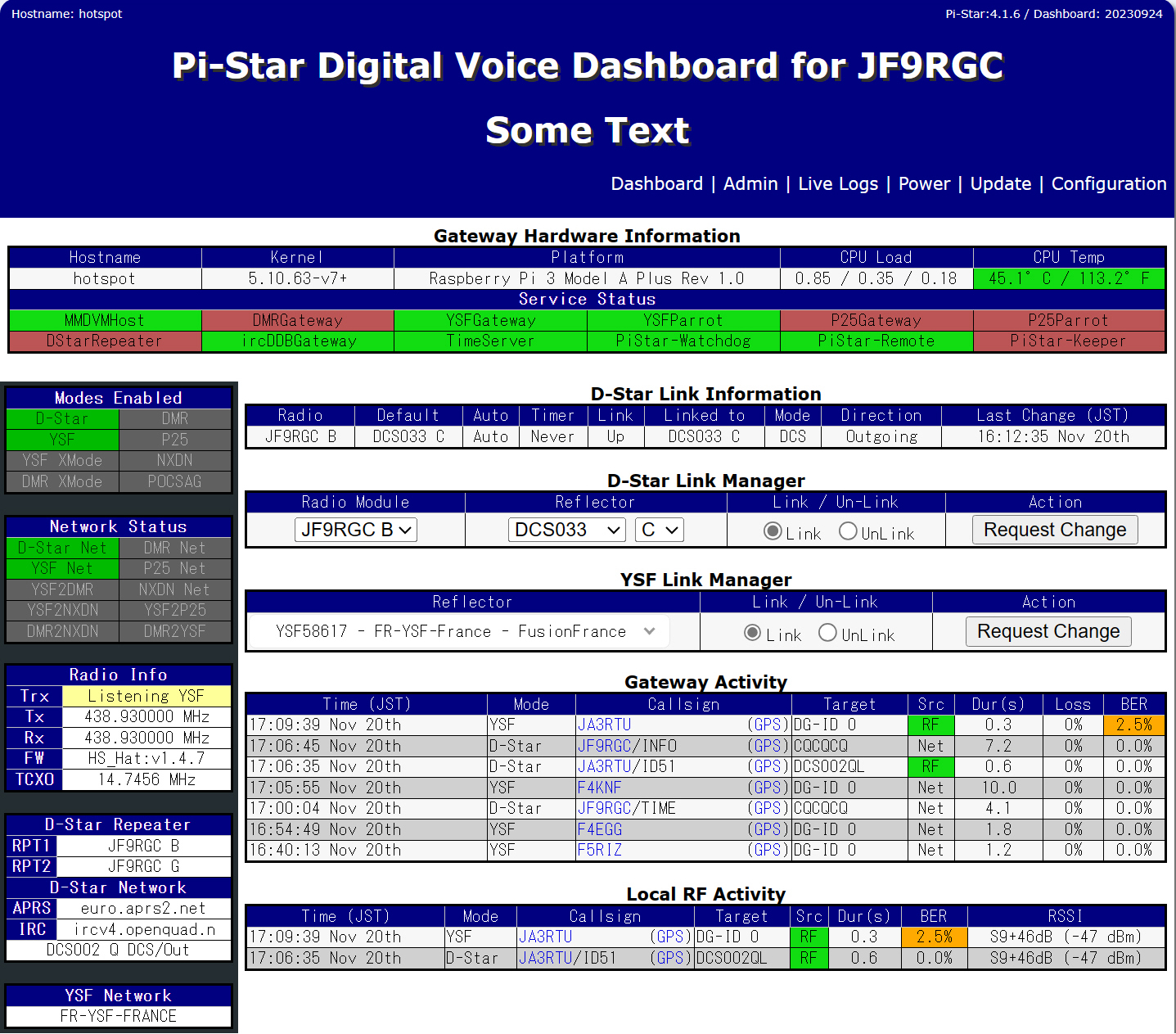
 The settings of this hotspot is realized by application called
Pi-Star controlled by Web browser. When I access it from a browser, the settings
screen appears, and I can set the call sign, the operating frequency, etc. I set up MMDVM to access from D-STAR and C4FM transceivers in order
to enter the D-STAR network and Yaesu System Fusion (YSF) network. When the hotspot is working, the dashboard indicates the CPU temperature of
Raspberry Pi, as well as the link status of the gateway. I setup the hotspot to link to D-STAR reflector or YSF nodes from this dashboard. For
D-STAR connection, it is also possible from the transceiver setting the destination to « TO ». When the signal is transmitted from my ID-51, the
display of the MMDVM board indicates that the hotspot is working in D-STAR mode and the hotspot listens D-STAR network. When « Radio Info » of the
dashboard displays « Listening », short chunk of FTM-300D changes the connecting network to YSF and the MMDVM board indicates as Fusion.
The modes are changed also automatically by the signal from Internat.
The settings of this hotspot is realized by application called
Pi-Star controlled by Web browser. When I access it from a browser, the settings
screen appears, and I can set the call sign, the operating frequency, etc. I set up MMDVM to access from D-STAR and C4FM transceivers in order
to enter the D-STAR network and Yaesu System Fusion (YSF) network. When the hotspot is working, the dashboard indicates the CPU temperature of
Raspberry Pi, as well as the link status of the gateway. I setup the hotspot to link to D-STAR reflector or YSF nodes from this dashboard. For
D-STAR connection, it is also possible from the transceiver setting the destination to « TO ». When the signal is transmitted from my ID-51, the
display of the MMDVM board indicates that the hotspot is working in D-STAR mode and the hotspot listens D-STAR network. When « Radio Info » of the
dashboard displays « Listening », short chunk of FTM-300D changes the connecting network to YSF and the MMDVM board indicates as Fusion.
The modes are changed also automatically by the signal from Internat.
The aforementioned WIRES-X is a network of Yaesu Radio Co.'s servers, so only the purchasers of Yaesu radio or HR-200 interface can enter this
network. On the other hand, the C4FM network YSF was developed in Germany and is completely different. It's easy to interact with DMR network,
and Pi-Star has this function. Between YSF and WIRES-X network, it requires bridge and only a few rooms are linked, such as America Link. Since
we are using the same digital platform, I hope that we will be able to link each other more easily in the future.
